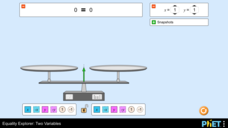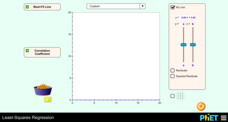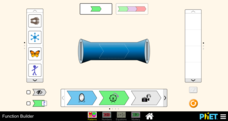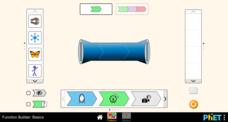Academy of American Poets
Teach This Poem: "The Teller of Tales" by Gabriela Mistral
The poem "The Teller of Tales" by Gabriela Mistral is the subject of a thoughtful lesson that allows scholars to listen to or read the poem, then discuss its meaning.
PHET
Equality Explorer: Two Variables
Solving equations in two variables can't be that much harder than solving equations in one variable. Using a balance interactive, scholars solve equations in two variables. They apply inverse operations by adding -x, -y, or -1 as...
PHET
Equality Explorer
Find the right balance between concrete and abstract thinking. After using interactive balances to explore inverse operations, learners solve multi-step equations with variables on both sides. Of course, they can still use the...
PHET
Equality Explorer: Basics
Not all interactives are made equal. Scholars use an interactive balance to explore the concept of equality. They place different objects on balances to determine the number of each object needed to balance the scale.
Anne Frank House
Who Was Anne Frank?
Set the stage for a study of The Diary of a Young Girl with a resource that includes background information about Anne Frank's early years, the Nazi invasion of the Netherlands, her Secret Annex hiding place, and her capture and...
Anne Frank House
Anne Frank House: The Secret Annex
A virtual tour of Amsterdam's Anne Frank House permits viewers to not only visit the Secret Annex but to also view photos and videos, examine a timeline of events, and learn about the fate of Anne Frank and her family.
The New York Times
Literary Pilgrimages: Exploring the Role of Place in Writers’ Lives and Work
Do the places you have lived influence what you write? Class members research the lives of writers and look for how places these writers have lived might have influenced their writings.
The New York Times
Where to Draw the Line: Balancing Government Surveillance with the Fourth Amendment
The question of how to balance Fourth Amendment Rights with national security concerns becomes critical in an age of planned terrorist attacks, election interference, and fake news. Get young social scientists involved in the debate with...
PHET
Vector Addition
Model vector addition graphically. A simple interactive has users add vectors and adjust the lengths and angles of the vectors. The interactive automatically updates the magnitude, angle, and components of the sum.
PHET
Trig Tour
Unit circles and trigonometric graphs go hand in hand. Pupils see how traversing the unit circle allows for the creation of graphs for trigonometric functions. They also see trigonometric ratios in terms of the ordered pairs of points on...
PHET
Plinko Probability
It's a good thing the resource dropped into your radar. Young mathematicians use an app that randomly drops balls through a Plinko game and into bins. They compare the distribution to that of an ideal binomial distribution.
PHET
Least-Squares Regression
Less is best when looking at residuals. Scholars use an interactive to informally fit a linear regression line to data on a scatter plot. The interactive provides a correct best fit line with residuals and correlation coefficient to...
PHET
Graphing Quadratics
Quadratics only have three terms, but each one is fairly important. Scholars use an interactive to explore how each coefficient affects the graph of a quadratic function. They also see how changes to the vertex form and how changes to...
PHET
Function Builder
Build confidence about functions with the function builder. Pupils learn about functions and transformations using an interactive. A function machine transforms pictures, numbers, and equations based on a function rule. A mystery...
PHET
Graphing Lines
Ready to increase pupils' understanding of slope with an upward slope? Scholars use an interactive that allows users to move two points on a coordinate plane. The interactive then automatically calculates the slope, the slope-intercept...
PHET
Function Builder: Basics
Learn about functions using the function builder app. A fun online interactive has the class conduct an investigation using a function machine. Inputs are pieces of art, and output are transformations of these pieces of art.

















